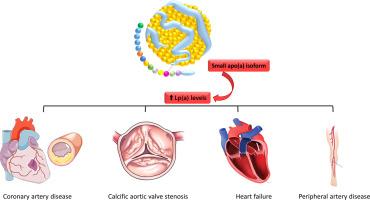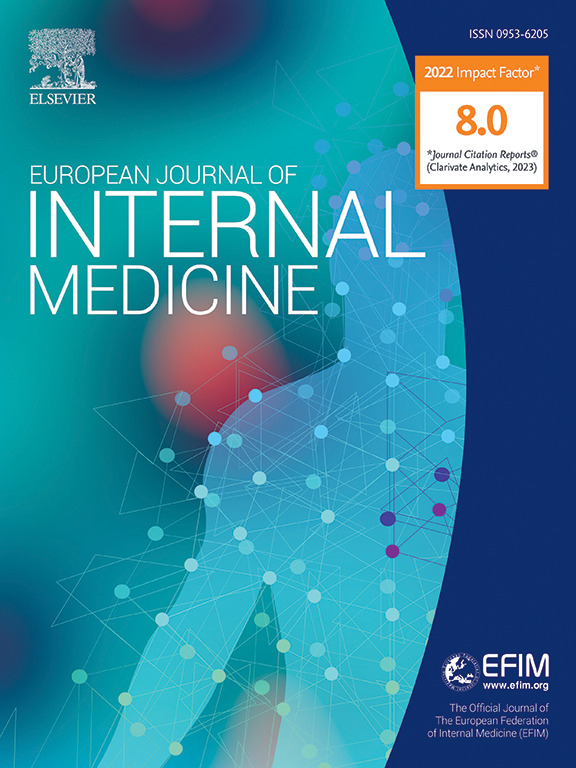Lipoprotein (a): A new target for pharmacological research and an option for treatment
IF 6.1
2区 医学
Q1 MEDICINE, GENERAL & INTERNAL
引用次数: 0
Abstract
Lipoprotein(a) [Lp(a)] is increasingly recognised as a crucial and independent risk factor for atherosclerotic cardiovascular disease (ASCVD), calcific aortic valve stenosis (AVS), and possibly heart failure and peripheral artery disease. Lp(a) consists of an LDL-like particle covalently bound to apolipoprotein(a) [apo(a)], a highly polymorphic protein encoded by the LPA gene. The Lp(a) level in plasma is predominantly genetically determined and remains stable throughout life, relatively unaffected by lifestyle, comorbidities or standard lipid-lowering therapies. Elevated Lp(a) levels are associated with a higher risk of ASCVD, particularly in individuals with familial hypercholesterolaemia or smaller apo(a) isoforms. Despite its clinical relevance, Lp(a) is rarely measured in daily clinical practice, although most guidelines recommend at least one lifetime measurement. Novel RNA-based therapies, including antisense oligonucleotides (pelacarsen) and small interfering RNAs (olpasiran, lepodisiran, zerlasiran)—have shown the potential to reduce Lp(a) levels by >80 %. The small oral molecule muvalaplin also shows promise in inhibiting Lp(a) formation. Large-scale clinical trials are underway to assess the effects of Lp(a)-lowering therapies on cardiovascular outcomes. Measurement of Lp(a) and characterisation of the isoforms remain a challenge, and standardisation of assays is still a matter of debate. As new therapeutic options are developed that specifically target Lp(a), the inclusion of Lp(a) in cardiovascular risk assessment could improve stratification and lead to targeted interventions, particularly in high-risk populations. The growing body of genetic, epidemiological and clinical evidence makes Lp(a) a critical target in cardiovascular research and therapy.

脂蛋白(a):药理学研究的新靶点和治疗的选择。
脂蛋白(a) [Lp(a)]越来越被认为是动脉粥样硬化性心血管疾病(ASCVD)、钙化性主动脉瓣狭窄(AVS),甚至可能是心力衰竭和外周动脉疾病的关键和独立危险因素。Lp(a)由一个与载脂蛋白(a) [apo(a)]共价结合的ldl样颗粒组成,载脂蛋白(a)是一种由LPA基因编码的高度多态性蛋白。血浆中的Lp(a)水平主要由遗传决定,并在整个生命中保持稳定,相对不受生活方式、合并症或标准降脂疗法的影响。Lp(a)水平升高与ASCVD的高风险相关,特别是在家族性高胆固醇血症或载脂蛋白(a)亚型较小的个体中。尽管Lp(a)具有临床意义,但在日常临床实践中很少测量,尽管大多数指南建议至少进行一次终身测量。新的rna疗法,包括反义寡核苷酸(pelacarsen)和小干扰rna (olpasiran, lepodisiran, zerlasiran),已经显示出将Lp(a)水平降低80 %的潜力。口服小分子muvalaplin也显示出抑制Lp(a)形成的希望。大规模临床试验正在进行中,以评估Lp(a)降低治疗对心血管预后的影响。Lp(a)的测量和同工异构体的表征仍然是一个挑战,测定的标准化仍然是一个有争议的问题。随着专门针对Lp(a)的新治疗方案的开发,将Lp(a)纳入心血管风险评估可以改善分层并导致有针对性的干预,特别是在高危人群中。越来越多的遗传、流行病学和临床证据使Lp(a)成为心血管研究和治疗的重要靶点。
本文章由计算机程序翻译,如有差异,请以英文原文为准。
求助全文
约1分钟内获得全文
求助全文
来源期刊
CiteScore
9.60
自引率
6.20%
发文量
364
审稿时长
20 days
期刊介绍:
The European Journal of Internal Medicine serves as the official journal of the European Federation of Internal Medicine and is the primary scientific reference for European academic and non-academic internists. It is dedicated to advancing science and practice in internal medicine across Europe. The journal publishes original articles, editorials, reviews, internal medicine flashcards, and other relevant information in the field. Both translational medicine and clinical studies are emphasized. EJIM aspires to be a leading platform for excellent clinical studies, with a focus on enhancing the quality of healthcare in European hospitals.

 求助内容:
求助内容: 应助结果提醒方式:
应助结果提醒方式:


